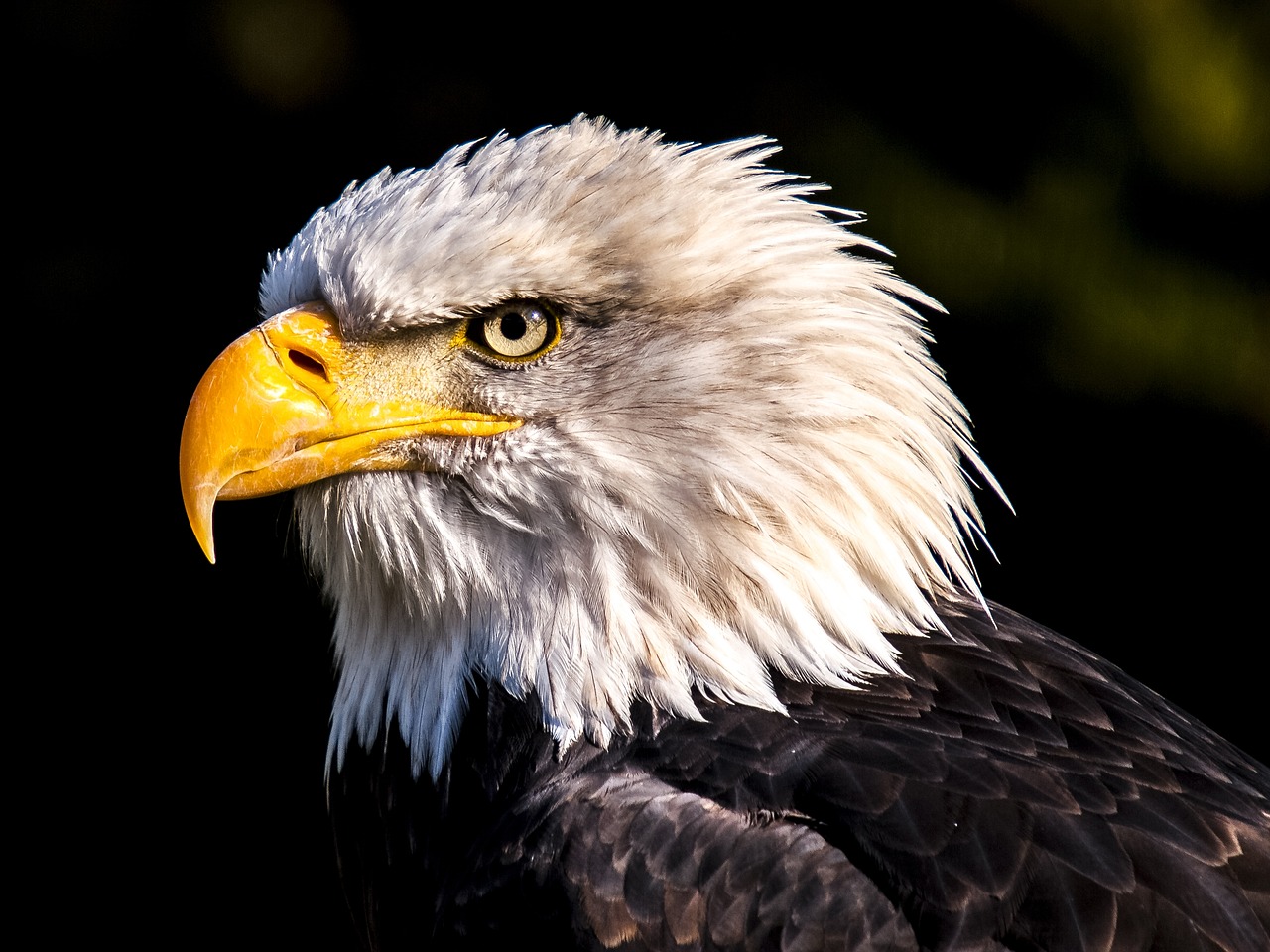Here are 50 interesting facts about these majestic birds:
- Bald eagles are the only eagle species that are solely native to North America.
- Bald eagles are not actually bald. Their name comes from the old English word “Balde”, which means white.
- Bald eagles have white feathers on their heads and tails, and dark brown feathers on their bodies and wings.
- Bald eagles have yellow beaks, eyes, and feet.
- Bald eagles are considered raptors, which are birds of prey that have sharp talons, curved beaks, and keen eyesight.
- Bald eagles are also known as sea eagles, because they often live near water and feed on fish.
- Bald eagles can have a wingspan of up to 8 feet (2.5 meters), which is the longest of any North American bird.
- Bald eagles can weigh between 6 to 14 pounds (2.7 to 6.4 kilograms), with females being larger than males.
- Bald eagles can fly up to 40 miles per hour (64 kilometers per hour) and dive at speeds of over 100 miles per hour (160 kilometers per hour).
- Bald eagles can see up to four times farther than humans, and can spot prey from up to a mile away.
- Bald eagles have a special membrane called a nictitating membrane that covers their eyes like a pair of sunglasses, protecting them from dust, wind, and sun glare.
- Bald eagles have about 7,000 feathers on their bodies, which help them regulate their body temperature and fly efficiently.
- Bald eagles can live up to 30 years in the wild, and even longer in captivity.
- Bald eagles mate for life, and usually return to the same nest every year.
- Bald eagles build the largest nests of any North American bird, which can measure up to 10 feet wide (3 meters) and weigh up to a ton (907 kilograms).
- Bald eagles lay two or three eggs once a year, which take about 35 days to hatch.
- Both parents share the duties of incubating and feeding the young, which are called eaglets.
- Eaglets grow rapidly and can weigh up to 10 pounds (4.5 kilograms) by the time they are 10 weeks old.
- Eaglets fledge (leave the nest) when they are about 12 weeks old, but they stay with their parents for another few months until they learn how to hunt and survive on their own.
- Eaglets do not develop their distinctive white head and tail feathers until they are four or five years old, when they also reach sexual maturity.
- Bald eagles are very vocal birds, and make a variety of calls such as whistles, chirps, and screams.
- Bald eagles have a complex social structure, and often form groups called convocations that consist of family members and other allies.
- Bald eagles communicate with each other through body language, such as tilting their heads, spreading their wings, or bobbing their heads.
- Bald eagles are very territorial, and will defend their nests and hunting grounds from intruders, including other bald eagles.
- Bald eagles sometimes engage in aerial battles with other raptors, such as ospreys or hawks, over food or territory.
- Bald eagles also sometimes perform spectacular courtship displays in the air, such as locking talons and spiraling down together.
- Bald eagles are opportunistic feeders, and will eat whatever is available, such as fish, birds, mammals, reptiles, amphibians, crustaceans, or carrion (dead animals).
- Bald eagles can catch fish by swooping down and plucking them out of the water with their talons, or by stealing them from other birds or animals.
- Bald eagles can carry up to half their body weight in their talons, and can lift up to 8 pounds (3.6 kilograms) of prey into the air.
- Bald eagles have a crop, which is a pouch in their throat where they can store food for later digestion.
- Bald eagles can go for several days without eating, but they can also gorge themselves and eat up to a pound (0.45 kilograms) of food at a time.
- Bald eagles regurgitate pellets of indigestible material, such as bones, feathers, or fur, after they digest their food.
- Bald eagles are very clean birds, and often bathe in water or preen their feathers with their beaks.
- Bald eagles have a gland near their tail called the uropygial gland, which secretes oil that they use to waterproof their feathers.
- Bald eagles molt (shed and replace their feathers) once a year, usually in late summer or early fall.
- Bald eagles are migratory birds, and will travel long distances to find suitable habitats and food sources depending on the season.
- Bald eagles have a large range, and can be found in every U.S. .
- Bald eagles are most abundant in Alaska and Canada, where there are estimated to be over 100,000 individuals.
- Bald eagles prefer to live in forested areas near large bodies of water, such as rivers, lakes, reservoirs, or coasts.
- Bald eagles are adaptable birds, and can also live in urban or suburban areas, as long as there is enough food and space for them.
- Bald eagles are sensitive to human disturbance, and will avoid nesting or roosting near areas with high human activity or noise.
- Bald eagles are protected by several laws and regulations in the U.S., such as the Bald and Golden Eagle Protection Act, the Migratory Bird Treaty Act, and the Endangered Species Act.
- Bald eagles were once endangered due to habitat loss, hunting, poisoning, and pesticide use, especially DDT, which caused their eggs to become thin and fragile.
- Bald eagles have made a remarkable recovery thanks to conservation efforts, such as banning DDT, protecting their habitats, reintroducing them to areas where they had disappeared, and educating the public about their importance.
- Bald eagles were removed from the endangered species list in 2007, but they are still considered threatened or vulnerable in some states.
- Bald eagles still face threats from illegal hunting, electrocution from power lines, collisions with vehicles or wind turbines, lead poisoning from ingesting contaminated prey, habitat loss or degradation, and climate change.
- Bald eagles are considered a keystone species, which means they play a vital role in maintaining the balance and health of their ecosystems.
- Bald eagles are also considered a flagship species, which means they serve as an emblem or symbol for conservation efforts and public awareness of environmental issues.
- Bald eagles have been the national emblem of the United States since 1782, when they were chosen by Congress for their strength, courage, beauty, and longevity.
- Bald eagles have inspired many people throughout history with their majestic appearance and behavior, and have been featured in art, literature, music, folklore, and culture of various nations and groups.
Facebook Comments


































